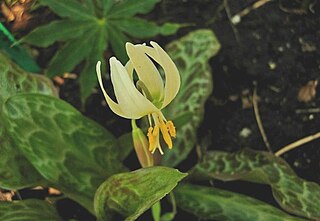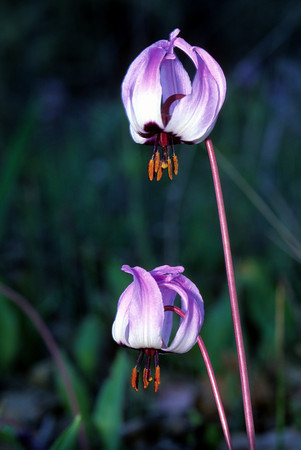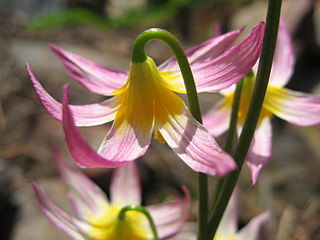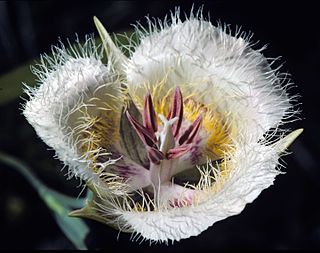
Erythronium albidum, the white fawnlily or white trout lily, is a small herbaceous geophyte in the lily family. It is also known as adder's tongue, whitedog's-tooth violet, serpent's tongue, trout lily, deer tongue, and yellow snowdrop. Large numbers of this plant indicate that the woodland has never been subjected to heavy machinery, where it would be unable to grow due to soil compaction.

Erythronium propullans, the Minnesota dwarf trout lily, Minnesota adder's tongue or Minnesota fawnlily, is a rare plant endemic to the Cannon River and North Fork Zumbro River watersheds in Rice County, Goodhue County and the extreme northern edge of Steele County, Minnesota, in the United States. The plants are believed to be a mutation or sport of the white trout lily and evolved following the most recent ice age. It was listed as an endangered species of the United States under the Endangered Species Act in 1986.

Erythronium americanum, the trout lily, yellow trout lily, or yellow dogtooth violet, is a species of perennial, colony forming, spring ephemeral flower native to North America and dwelling in woodland habitats. Within its range it is a very common and widespread species, especially in eastern North America. The common name "trout lily" refers to the appearance of its gray-green leaves mottled with brown or gray, which allegedly resemble the coloring of brook trout.

Erythronium revolutum is a species of flowering plant in the family Liliaceae which is known by several common names, including mahogany fawn lily, coast fawn lily, and pink fawn lily. It is native to the west coast of North America.

Erythronium citrinum, also known as citrus fawn lily or cream fawn lily, is a member of the lily family that is endemic to the Klamath Mountains. It is found in southwest Oregon and adjacent northwest California. The genus Erythronium, which can be found across northern North America, Europe and Asia, is most diverse in California, which is home to fifteen of about twenty-eight members of the genus.

Erythronium hendersonii, or Henderson's fawn lily, is a plant in the lily family native to southwestern Oregon, and northern California. It can be locally very abundant within its range which is in the Rogue River, and Applegate River drainage basins in Josephine County and Jackson County in Oregon, and well as sites in Siskiyou, Del Norte, and Mendocino Counties in California.

Erythronium californicum, the California fawn lily, is a species of flowering plant in the family Liliaceae, endemic to moist woodland habitats in the mountains of Northern California.

Erythronium grandiflorum is a North American species of plants in the lily family. It is known by several common names, including yellow avalanche lily, glacier lily, and dogtooth fawn lily. The Ktunaxa name for glacier lily is maxa.

Erythronium helenae is a species of flowering plant in the lily family which is known by the common names Pacific fawn lily and St. Helena fawn lily. It is endemic to the coastal mountains north of the San Francisco Bay Area in California. It is named for the local peak Mount Saint Helena, forming the point where Napa, Sonoma and Lake Counties meet. It grows on the slopes of the mountain at elevations of 500–1200 m, often on serpentine soils.

Erythronium multiscapideum is a California species of flowering plant in the lily family which is known by the common name Sierra fawn lily.

Erythronium oregonum is a North American species of flowering plant in the lily family which is known by the common name giant white fawnlily or Oregon fawn-lily.
Erythronium pluriflorum is a rare species of flowering plant in the lily family Liliaceae which is known by the common names manyflower fawn lily,golden fawn-lily, and Shuteye Peak fawn lily.

Erythronium purpurascens is a species of flowering plant in the lily family which is known by the common names purple fawn lily and Sierra Nevada fawn lily.

Erythronium tuolumnense is a species of flowering plant in the family Liliaceae, known by the common name Tuolumne fawn lily or Tuolumne dog's tooth violet. However, it is neither a true lily nor a violet. It is endemic to the Sierra Nevada of Tuolumne County, California; from 600 m (1,969 ft) along Italian Bar Road up to 1,000 m (3,281 ft) altitude at the headwaters of Deer Creek.

Calochortus leichtlinii is a species of flowering plant in the lily family known by the common names Leichtlin's mariposa, smokey mariposa, and mariposa lily.

Calochortus obispoensis is a rare California species of flowering plants in the lily family known by the common name San Luis mariposa lily. It is endemic to San Luis Obispo County, California, where it grows in the chaparral of the coastal mountains, generally on serpentine soils.

Erythronium pusaterii is a species of flowering plant in the lily family known by the common names Kaweah Lakes fawn lily and Hocket Lakes fawn lily.

Erythronium taylorii is a rare species of flowering plant in the lily family known by the common names Pilot Ridge fawn lily, Taylor's fawnlily, and Yosemite fawn lily. It is endemic to Tuolumne County, California, where it is known only from Pilot Ridge, a remote mountain ridge outside of Yosemite National Park. It was discovered in 1996 and described to science as E. taylori in 1997, and it is now called E. taylorii. There are at least 1000 individuals in the single known population. It occurs on shaded north-facing cliffs.
Erythronium elegans is a rare species of flowering plant in the lily family known by the common names Coast Range fawnlily and elegant fawnlily. It is endemic to Oregon in the United States, where it is known from about 12 occurrences in the northern Coast Range.

Calochortus coxii is a rare species of flowering plant in the lily family known by the common names Cox's mariposa lily and crinite mariposa lily. It is endemic to Oregon in the United States, where it is known only from Douglas County.



















